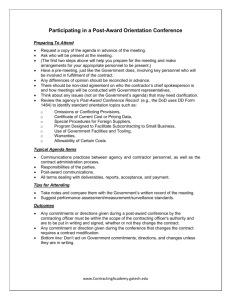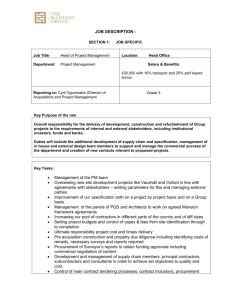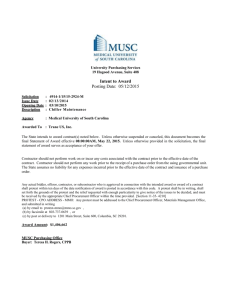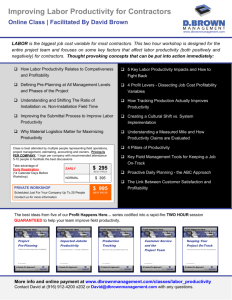DESIGN PATENTS
advertisement
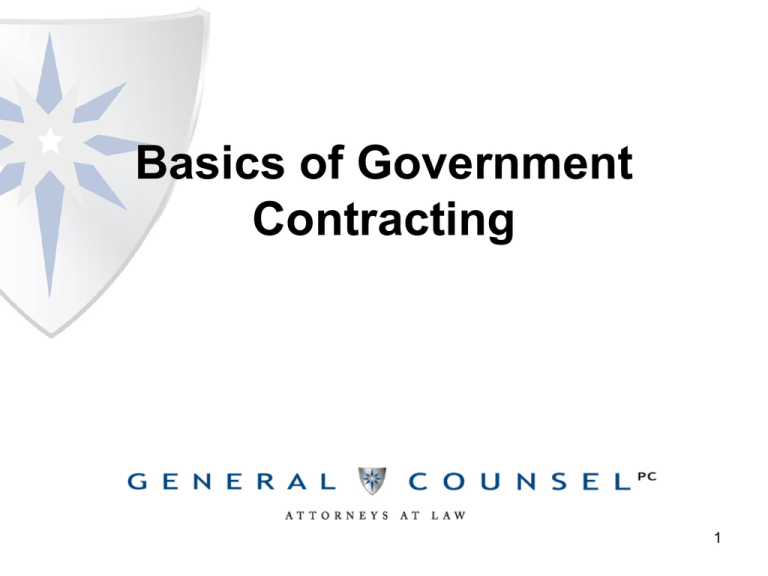
Basics of Government Contracting 1 Federal Procurement Background • The U.S. Government is the world’s largest purchaser of goods and services 2 Federal Procurement Background • The U.S. Government is the world’s largest purchaser of goods and services • All of this procurement is highly regulated, primarily by the Federal Acquisition Regulation (FAR) 3 Federal Procurement Background • The FAR requires full and open competition for federal contracts – Naturally, there are exceptions 4 Federal Procurement Background • Exceptions to “full and open” competition – Sole Source Contracts – Statutory Requirement – Small Business Set-Asides • The Government has a “goal” that 23% of all Federal Contract dollars will go to small businesses 5 What is a small business set-aside? 6 Small Business Set-Asides • “Set-aside” – Contract opportunity limited to small business (or certain type of small business) • Federal Agencies are encouraged, and sometimes required, to set aside a contract • Automatic set-aside if between $3K - $150K 7 Small Business Set-Asides • “Rule of Two” – Contract must be set-aside if: – Valued at over $150K; – Reasonable expectation to receive offers from at least 2 small businesses; and – Award will be made at fair market price. 8 Small Business Set-Asides – Types of Small Business Programs: • • • • Small business set-aside 8(a) business development set-asides HUBZone set-asides Service-disabled veteran-owned, and veteran-owned small business set-asides (SDVOSB & VOSB) • Women-owned small business set-asides 9 How does the government procure goods and services? 10 Simplified Procurement Process – The Government announces what it needs • Fedbizopps.gov – Interested contractors submit offers to fill those needs – Offers are reviewed and evaluated – Contract Award The procuring agency enters into a contract with the selected offeror 11 Simplified Procurement Process • Two Primary Procurement Methods – Sealed Bidding (FAR Part 14) – Negotiated Procurements (FAR Part 15) • More prevalent • GSA Schedules 12 Sealed Bidding • Government issues an Invitation for Bids (IFB) – Contains all necessary specs and requirements • Interested contractors submit a Bid – Must agree to all contract requirements – Really all about price 13 Sealed Bidding • All bids are opened publicly – Award made to lowest priced responsive bid – If lowest bidder determined nonresponsive, goes to next in line 14 Negotiated Procurements • Government issues a Request for Proposals (RFP) – Agency must follow terms of the RFP • Interested contractors submit a Proposal – Demonstrate how they can meet RFP requirements and at what price 15 Negotiated Procurements • Agencies can make an award based on initial proposals, or enter into “discussions” with offerors • Where there are many proposals, agencies may establish a “competitive range” 16 Negotiated Procurements • After final proposals, agency makes award decision based on process identified in RFP. – Referred to as “source selection decision” 17 Negotiated Procurements • Debriefings – After award, unsuccessful offerors may request a post-award debriefing – Agency must provide the debriefing – Opportunity for contractor to pose questions to agency as to why its offer was not selected 18 GSA Schedules • Allows Federal Agencies to quickly purchase commercial items and services from listed vendors – Vendors apply to GSA Schedules – GSA awards schedule contract with set prices/rates – Contracts last up to 20 years 19 Types of Government Contracts – Firm fixed-price All risk on the contractor – Cost Reimbursement Risk primarily on government • Also Cost plus Fee, and Cost plus Incentive – Time and Materials • Fixed hourly rates, must have a ceiling cost – Indefinite Delivery, Indefinite Quantity (ID/IQ) 20 What are the difference between government and private contracts? 21 Government vs. Private • Changes Clause – Contractor must do all additional work ordered by agency, as long as it’s within scope of the contract – Contractor can submit request for equitable adjustment 22 Government vs. Private • Termination for Convenience of the Government – Government can terminate any gov’t contract, for any reason, at any time – Contractor can recover costs associated w/ termination • No lost profits though 23 Government vs. Private • Disputes over government contracts are highly regulated and very rarely litigated in traditional courts • Generally three types of disputes in government contracting: – Pre-award – Post-award – Performance related 24 Pre-Award Disputes • Contractors can protest terms of solicitation – Too restrictive, ambiguous – Protest can be filed with either Government Accountability Office (GAO) or Court of Federal Claims • Contractors can also protest exclusion from “competitive range” 25 Post-Award Disputes • Contractors can protest the award decision – e.g., Improper evaluation • Post-award protests can be filed in 3 forums: – Agency – GAO – Court of Federal Claims 26 Post-Award Disputes • GAO Protests – Interested parties have 10 days to protest – Automatic Stay is available – Generally, the awardee is allowed to intervene – Decision due within 100 days – Generally best option 27 Performance Disputes • Disputes begin with a claim for money submitted to the contracting officer – CO has 60 days to issue Final Decision responding to claim 28 Performance Disputes • Contractors can appeal denial of claim in one of two forums: – Board of Contract Appeals – Civilian Board, Armed Services Board – Court of Federal Claims • Cannot appeal to both, must choose one or other 29 Performance Disputes • Appeals to Boards of Contract Appeals – Must file appeal within 90 days of Final Decision or deemed denial • Appeals to Court of Federal Claims – Must file within 1 year of denial • Federal Circuit hears appeals of these decisions 30 Teaming Agreements and Subcontracts 31 Teaming Agreements – Multiple companies agree to compete as a team, usually before proposal • Teaming Agreement between Prime Contractor and Subcontractor(s) – Generally, parties agree to negotiate subcontract in good faith • Joint Venture – Multiple companies agree to perform together as the Prime Contractor – Binding Contracts 32 Subcontracts • Defines the relationship between Prime and Subcontractor – Typically executed after award – Should include Sub’s scope of work – Provisions from prime contract can “flow down” to subcontract 33 Basics of Government Contracting Contact Info: General Counsel, P.C. 703-556-0411 info@gcpc.com 34

